Kosher and Traditional Jewish Cooking: Authentic Recipes From a Classic Culinary Heritage: 130 Delicious Dishes Shown in 220 Stunning Photographs (41 page)
Authors: Marlena Spieler

Chicken is often first simmered in water or stock to make soup, then roasted for a main course.
Meatballs made from minced (ground) chicken were a favourite food of Persian and Turkish Jews, especially when simmered along with aubergine (eggplant). Iraqis were famous for their spiced chicken croquettes, which they introduced to India and Burma. Indian Jews cook marvellous chicken curries, substituting coconut milk for yogurt, which is not permitted with chicken.
A favourite Sephardi dish, eaten on the streets of Jerusalem, consists of chicken giblets and livers, grilled (broiled) until they are brown and crisp, and then eaten immediately with freshly cooked pitta bread and a very hot, spicy pepper sauce.
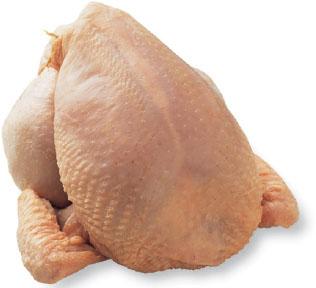
Chicken is used in an array of classic Jewish dishes.
Turkey, duck, goose and farmed pigeon (US squab), quail and poussin are also eaten. In Morocco, it is traditional for bridal couples to be served pigeons cooked with sweet fruits on their wedding night, to grant them a sweet life together.
In the Sephardi tradition, birds were often stuffed with couscous, spicy meat, rice and dried fruit, or with herbs and milder spices such as cinnamon. The Sephardim also liked stewed poultry with quinces or pomegranates, or flavoured with tomatoes, (bell) peppers, chickpeas or olives. The art of raising geese for foie gras was acquired by Jews in Ancient Egypt, and it is believed that it was they who introduced the delicacy to France.
Rendered chicken fat (schmaltz), and the crisp morsels of skin left over after rendering (grebenes), are widely used in Jewish cooking. Schmaltz was long considered a symbol of abundance and there is a traditional Yiddish saying, “He’s so lucky that even when he falls, he falls right into a schmaltz!” Spread schmaltz on bread with onions or use it to flavour cholent or to make chopped liver.
One chicken won’t make very much schmaltz, so save the fat and skin from several chickens and chill in the refrigerator or freeze until you have 450g/1lb.
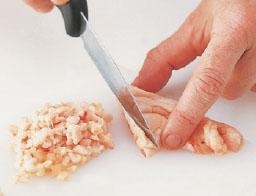
1
Cut the fat and skin into small pieces. Place in a large, heavy pan and pour over water to cover. Bring to the boil and cook over a high heat until the water has evaporated.
2
Lower the heat and add about 2
1
/
2
chopped onions and 1–2 garlic cloves.
3
Cook over a medium heat, removing the garlic when golden.
4
When all the chicken fat has been rendered and the grebenes are crunchy, remove the grebenes carefully with a slotted spoon.
Permitted types of fish are classified as
pareve
, so there are no restrictions with regard to combining them with other ingredients. Its versatility makes fish extremely important on the Jewish dinner table. It may hold centre stage, as when a whole fish is served at Rosh Hashanah, but more often it is served as an appetizer or as one of several dishes as part of a buffet.
From the fresh fish counter, there is always a wide choice on offer. Sea bass, cod, sole and flounder, haddock, hake and mackerel are all popular sea fish, with perch, pike and trout among the best-loved of the freshwater varieties.
Some fish are thought of as being more Jewish than others. However, this apparent preference for certain fish has simply come about because of geography and traditional availability.
For example, carp is a particular favourite among Ashkenazi Jews, as is pike. Carp was brought to Europe by Jews who encountered it in China when they were involved in the silk trade in the 15th century, while pike was introduced into the USA from Germany in the 19th century and grew in popularity as waves of Jewish immigrants arrived in the country from all over the world.
This traditional, and delicious, dish of poached carp in jelly is a legacy of the Jews of Eastern Europe.
1
Cut 1kg/2
1
/
4
lb prepared fresh carp into 8–10 slices. Heat 15ml/1 tbsp oil in a large pan. Add 2
1
/
2
chopped onions and sauté until golden brown.
2
Add 2–3 bay leaves, 1–2 parsley and thyme sprigs, 1–2 lemon slices and the carp to the pan and season well.
3
Pour 450ml/
3
/
4
pint/2 cups hot fish stock and 250ml/8fl oz/1 cup white wine into the pan. Bring to the boil, then simmer for 1 hour until the fish is tender. Cool slightly, then remove the carp and pack it into a mould.
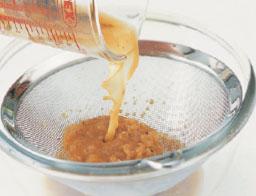
4
Strain the fish stock through a fine sieve (strainer) into a large bowl.
5
Dissolve 2 sachets of kosher gelatine in 150ml/
1
/
4
pint/
2
/
3
cup of the stock, then stir into the remaining stock. Pour the mixture over the fish and chill in the refrigerator until firm.
6
Serve the jellied carp with lemon wedges and horseradish.
No Ashkenazi celebration is complete without some kind of fish from the deli counter. A good deli will smell deliciously of smoked and cured fish.
The art of preserving fish is a speciality of the Ashkenazi Jews. They perfected the technique so that stocks of fish would last all year. Methods used included salting, brining, smoking and marinating.
In a good deli you will find silky smoked salmon (lox), its natural orange colour providing a contrast to the smoked whitefish in its shimmering gold skin. In addition there will be salt herring, smoked herring, pickled herring, herring in sour cream, herring in brine and herring salad. You will find also gefilte fish in the deli, either freshly made or ready-made in jars, the liquid jellied and flavoured sweetly in the Polish manner, or spicy and peppery, in the typical Russian or Lithuanian tradition.
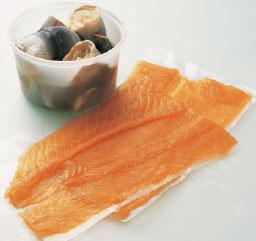
Spicy, piquant pickled herring rollmops and thinly sliced smoked salmon are perfect for a Shabbat brunch.
For Jews, grains, beans, peas and lentils have long been the staff of life and have fuelled generations.
In many places, a certain type of grain or pulse (legume) actually helped to define the cuisine of the community. In Romania it was mamaliga, a cornmeal porridge that resembles polenta; in North Africa it was couscous; and for many places in the East, the staple food was rice. In Russia, Poland and the Ukraine, kasha (buckwheat) was widely eaten. Pulses are added to cholent, hamim and dafina, the slow-cooked stews that are traditionally served for Shabbat.
This nutty, earthy grain is the partially milled grain or groat of buckwheat. It is traditionally used in Ashkenazi cooking and is very evocative for Ashkenazim who grew up eating it. Kasha is traditionally served with roasts and pot-roasts, bathed in gravy and meat juices, or may be used as a filling for knishes and dumplings. It can also be combined with onions, wild mushrooms and noodles. Kasha varnishkes, a classic Ashkenazi dish of kasha, butterfly-shaped noodles and onions, is traditionally eaten at the festival of Purim.
The grains may be fine, medium or coarse. Kasha should be toasted before being cooked, to keep it from going mushy and give it a nutty flavour. It is often toasted with egg before being simmered, to keep the grains separate.
To toast kasha, heat in a heavy pan over a medium heat for a few minutes until the grains start to give off their aroma. Add stock, bring to the boil, reduce the heat and cover. Simmer gently for 10–20 minutes until tender.
To toast kasha with egg, combine about 250g/9oz/1
1
/
4
cups kasha in a bowl with 1 beaten egg. Add the mixture to a cold heavy pan. Stir
well, then turn on the heat to medium-high. Stir constantly while the grains toast and the egg sets. When the grains look dry, add stock or water and cook the kasha as above.
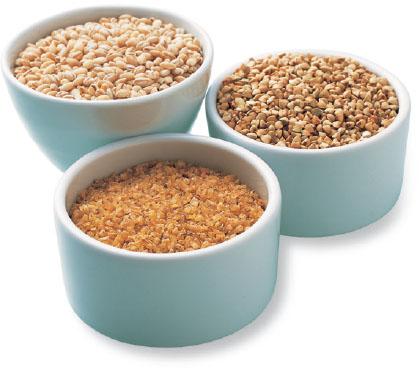
Pareve
grains such as barley, kasha (buckwheat) and bulgur wheat are important staples in both the Ashkenazi